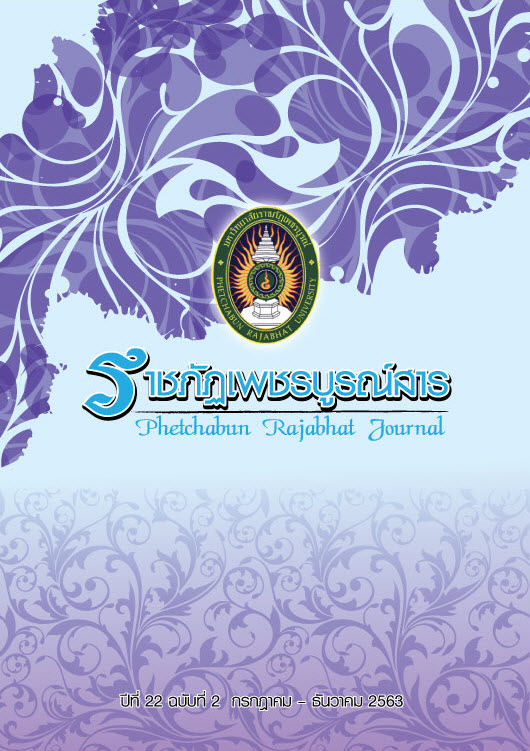Using Group Discussion to Promote English Speaking and Writing Abilities and to Reduce English Classroom Anxiety of Learners
Main Article Content
Abstract
The research study entitled using group discussion to promote english speaking and writing abilities and to reduce english classroom anxiety of learners was aimed at 1) comparing the learners' english-speaking abilities before and after classroom with group discussion 2) comparing the learners' english-writing abilities before and after classroom with group discussion and 3) comparing the learners' english classroom anxieties before and after classroom with group discussion. The tools used in this research included a lesson plan used in the group discussion, english speaking ability test form with difficulty of 0.43, discrimination power of 0.27, reliability of 0.88, english writing ability test form with difficulty of 0.47, discrimination power of 0.33, reliability of 0.83, and english classroom anxiety test form with reliability of 0.85. The samples from purposive sampling included 27 people. Data was analyzed by using statistics including percentage, mean, standard deviation and dependent sample t-test.
The research results were as follows: 1) the learners’ english speaking ability was found that before classroom with group discussion, the learners were at a fair level of 33% (average 11.1 points), and after classroom, the learners were in very good level of 92.6% (average 16.9 points), with t value at -14.060 2) the learners’ english writing ability was found that before classroom with group discussion, the learners were at a poor level of 100% (average 8.3 points), and after classroom, the learners were at a moderate level of 59.3% (average 14.6 points), with t value at -19.441 and 3) anxiety of the learners before classroom with group discussions was found at a high level of 11.1% (average 27.3 points), and after classroom, the learners were at a high level of 3.7% (average 21.8 points). The english classroom anxiety was reduced by 5.5 points, with t value at 3.151.
The research findings were as following: 1. According to the speaking abilities of the learners, it was found that before learning by using Group Discussion, most of learners were at fair level with the number of 9, percentage of 33 having average score as 11.1 and after the learning by using Group Discussion, most of learners were at high level with the number of 25 and the percentage of 92.6 having average score as 16.9. The speaking abilities score was increased 5.8 and there was statistical significance as 0.05 (P < 0.001). 2. Regarding to the writing abilities of the learners, it was found the before learning by using Group Discussion, 27 learners were at poor level with percentage of 100 and average score as 8.3 and after learning by using Group Discussion, most of learners were at moderate level with the number of 16, the percentage of 59.3 and average score as 14.6. The writing abilities score was increased 6.3 with statistical significance as 0.05 (P < 0.001). 3. Referring to English classroom anxiety of the learners, it was found that before learning by using Group Discussion, 3 learners were at high level with the percentage of 11.1 and average score as 27.3 and after learning by using group discussion, 1 learner was at high level with the percentage of 3.7 and average score as 21.8. The English classroom anxiety was decreased 5.5 with statistical significance as 0.05 (P =0.004).
Article Details
เนื้อหาและข้อมูลในบทความที่ลงตีพิมพ์ในวารสาร ถือเป็นข้อคิดเห็นและความรับผิดชอบของผู้เขียนบทความโดยตรง ซึ่งกองบรรณาธิการวารสารไม่จำเป็นต้องเห็นด้วย หรือร่วมรับผิดชอบใด ๆ
References
ชินณเพ็ญ รัตนวงศ์. (2547). ผลของการสอนโดยใช้งานปฏิบัติเป็นฐานในการเรียนรู้ ที่มีต่อความสามารถในการใช้ภาษาอังกฤษเพื่อการสื่อสารของนักเรียน ชั้นมัธยมศึกษาปีที่ 6. (วิทยานิพนธ์ครุศาสตรมหาบัณฑิต). จุฬาลงกรณ์มหาวิทยาลัย, บัณฑิตวิทยาลัย, สาขาหลักสูตรและการสอน.
ทิศนา แขมมณี. (2547). ศาสตร์การสอน องค์ความรู้เพื่อการจัดกระบวนการเรียนรู้ที่มีประสิทธิภาพ. พิมพ์ครั้งที่ 3. กรุงเทพฯ: ด่านสุทธาการพิมพ์.
พูนรัตน์ แสงหนุ่ม. (2538). ผลของวิธีการเขียนแบบเน้นกระบวนการที่มีต่อความสามารถในการเขียนภาษาอังกฤษและความคิดเห็นเกี่ยวกับบรรยากาศในชั้นเรียนของนักศึกษาโปรแกรมวิชาภาษาอังกฤษ สถาบันราชภัฎเชียงใหม่. (วิทยานิพนธ์ศึกษาศาสตรมหาบัณฑิต). มหาวิทยาลัยเชียงใหม่, บัณฑิตวิทยาลัย, สาขาการสอนภาษาอังกฤษ.
รจนา ชัยมีเขียว. (2530). การเปรียบเทียบผลสัมฤทธิ์และความสนใจต่อวิธีการสอนพูดของนักเรียนชั้นมัธยมศึกษาปีที่ 3 ที่สอนโดยการอภิปรายกลุ่ม การแสดงบทบาทสมมุติและการสอนตามคู่มือครู. (วิทยานิพนธ์การศึกษามหาบัณฑิต). มหาวิทยาลัยศรีนครินทรวิโรฒประสานมิตร, บัณฑิตวิทยาลัย, สาขาวิชามัธยมศึกษา.
สมเกียรติ อ่อนวิมล. (2554, 13 กรกฎาคม). บันทึกอาเซียน ASEAN DIARY : การใช้ภาษาอังกฤษและภาษาอื่นในภูมิภาคกับอนาคตของไทยในอาเซียน. เดลินิวส์, น. 1.
Barry and Francis Joseph. (1985, February). Small Group Discussion as a Prewriting Activity: A Naturalistic Inquiry Dissertation. Abstracts International 45, 3(1), 60-66.
Cimcoz. (1999, 5 June). Teaching ESL/EFL Students to Write Better. The Internet TESL Journal, 5(10),50-56.
Clark, Leonard H. and Irving Starr. (1976). Secondary School Teaching Methods. 3rd ed. New York: Macmillan Publishing Co., Inc.
Halbert and Gulley E.. (1963). Discussion Conference and Group Process. New York: Holt Rinehartand Winston Inc.
Horwitz and Cope. (1986, July). Foreign language classroom anxiety. The Modern language Journal,70(2), 125-132.
Hynes and Sister Nancy. (1970, March). Learning to Read Short Stories. Journal of Reading, 4(8), 429-432.
Jacobs (1981). Testing ESL composition: a practical approach. 5th ed. Massachusetts: Newbury House Publishers, Inc.
Littlewood. (1984). Foreign and second language learning: Language acquisition research and its implications for the classroom. Cambridge: Cambridge University Press.
Oller, J. W. (1979). Language tests at school. London: Longman Group Limited.

